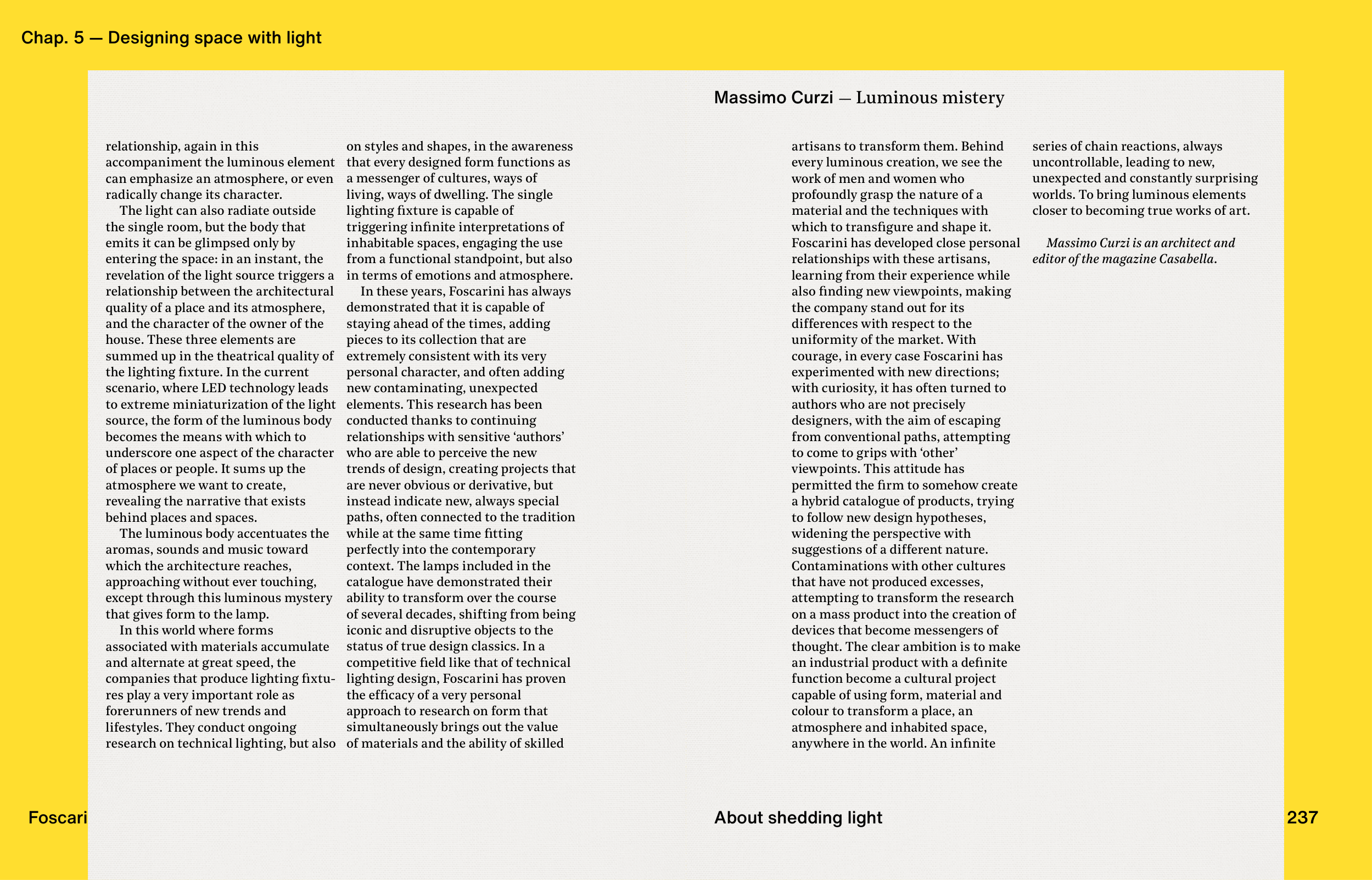237
Foscarini
Chap. 5 — Designing space with light
relationship, again in this
accompaniment the luminous element
can emphasize an atmosphere, or even
radically change its character.
The light can also radiate outside
the single room, but the body that
emits it can be glimpsed only by
entering the space: in an instant, the
revelation of the light source triggers a
relationship between the architectural
quality of a place and its atmosphere,
and the character of the owner of the
house. These three elements are
summed up in the theatrical quality of
the lighting fi xture. In the current
scenario, where LED technology leads
to extreme miniaturization of the light
source, the form of the luminous body
becomes the means with which to
underscore one aspect of the character
of places or people. It sums up the
atmosphere we want to create,
revealing the narrative that exists
behind places and spaces.
The luminous body accentuates the
aromas, sounds and music toward
which the architecture reaches,
approaching without ever touching,
except through this luminous mystery
that gives form to the lamp.
In this world where forms
associated with materials accumulate
and alternate at great speed, the
companies that produce lighting fi xtu-
res play a very important role as
forerunners of new trends and
lifestyles. They conduct ongoing
research on technical lighting, but also
on styles and shapes, in the awareness
that every designed form functions as
a messenger of cultures, ways of
living, ways of dwelling. The single
lighting fi xture is capable of
triggering infi nite interpretations of
inhabitable spaces, engaging the use
from a functional standpoint, but also
in terms of emotions and atmosphere.
In these years, Foscarini has always
demonstrated that it is capable of
staying ahead of the times, adding
pieces to its collection that are
extremely consistent with its very
personal character, and often adding
new contaminating, unexpected
elements. This research has been
conducted thanks to continuing
relationships with sensitive ‘authors’
who are able to perceive the new
trends of design, creating projects that
are never obvious or derivative, but
instead indicate new, always special
paths, often connected to the tradition
while at the same time fi tting
perfectly into the contemporary
context. The lamps included in the
catalogue have demonstrated their
ability to transform over the course
of several decades, shifting from being
iconic and disruptive objects to the
status of true design classics. In a
competitive fi eld like that of technical
lighting design, Foscarini has proven
the effi cacy of a very personal
approach to research on form that
simultaneously brings out the value
of materials and the ability of skilled
About shedding light
artisans to transform them. Behind
every luminous creation, we see the
work of men and women who
profoundly grasp the nature of a
material and the techniques with
which to transfi gure and shape it.
Foscarini has developed close personal
relationships with these artisans,
learning from their experience while
also fi nding new viewpoints, making
the company stand out for its
differences with respect to the
uniformity of the market. With
courage, in every case Foscarini has
experimented with new directions;
with curiosity, it has often turned to
authors who are not precisely
designers, with the aim of escaping
from conventional paths, attempting
to come to grips with ‘other’
viewpoints. This attitude has
permitted the fi rm to somehow create
a hybrid catalogue of products, trying
to follow new design hypotheses,
widening the perspective with
suggestions of a different nature.
Contaminations with other cultures
that have not produced excesses,
attempting to transform the research
on a mass product into the creation of
devices that become messengers of
thought. The clear ambition is to make
an industrial product with a defi nite
function become a cultural project
capable of using form, material and
colour to transform a place, an
atmosphere and inhabited space,
anywhere in the world. An infi nite
series of chain reactions, always
uncontrollable, leading to new,
unexpected and constantly surprising
worlds. To bring luminous elements
closer to becoming true works of art.
Massimo Curzi is an architect and
editor of the magazine Casabella.
Massimo Curzi — Luminous mistery
237


